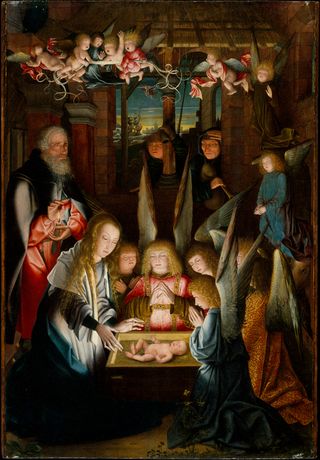by Timothy Rutt
As is our custom, entries will be light or nonexistent today, as we celebrate the nativity of the Lord with our family. And we tell our Christmas story;
 Almost 20 years ago, we were looking for a creche -- we never had one growing up, and felt that it was time to have one. Because we are also cheap, we finally found one in the after-Christmas sale at the Folk Tree Gallery in Pasadena for half off -- a simple set of painted terra cotta figurines from Peru. We liked it very much, so we bought it, they boxed it up, and we took it home.
Almost 20 years ago, we were looking for a creche -- we never had one growing up, and felt that it was time to have one. Because we are also cheap, we finally found one in the after-Christmas sale at the Folk Tree Gallery in Pasadena for half off -- a simple set of painted terra cotta figurines from Peru. We liked it very much, so we bought it, they boxed it up, and we took it home.
But as we unpacked the box, we found out that we had a passenger -- a terra cotta cow in a totally different style. It had a broken-off horn and a leg was just barely hanging on -- obviously from another set, broken and put in the box in the back room to be thrown away later. But they used the box to pack my set and didn't notice the cow already in it.
This was my first nativity set, and we had a problem. What do you do with a broken, non-matching piece? Throw it away? Maybe -- but there's a protocol for getting rid of worn out American flags -- maybe there's some kind of protocol for broken creche pieces? I had no idea. We set up the nativity set, and put the broken cow in the back until we could figure out what to do with her.
For several years we just packed her and forgot about her until the next year. Sometimes she was put in the back of the display, where her non-matching brokenness wouldn't distract too much. Sometimes we just left her in the box as we brought out the other pieces ... but never threw her away.
Over time, tho', she has moved more to the front of the display, and now she is placed nearest the Christ Child. This is fitting somehow. Everyone we know is broken and doesn't match the rest of the pieces. That just means she needs to be there -- in fact, she's the one the whole event is for.
Per our usual custom, our traditional Christmas picture is a Flemish painting by an unknown artist, c. 1515, "Adoration of the Christ Child," which is in the Metropolitan Museum of Art in New York. Several years ago, psychiatrist Andrew Levitas and geneticist Cheryl Reid determined that the angel closest to Mary, and possibly the shepherd in the middle, bore the distinctive facial evidence of Down Syndrome. They conjectured that the artist used models with Down Syndrome fully three centuries before the condition was identified by Dr. Langdon Down. And the artist didn't call attention to it -- in fact, they're representing beings (shepherds and angels) who are meant to be there. Imperfect and somewhat damaged, as we all are, but also welcomed to the Nativity. As our family has cherished members with Down Syndrome -- more broken and non-matching cows all -- this has particular appeal to our heart. Everyone is invited to this party!
Celebrate the day! Merry Christmas to you!



